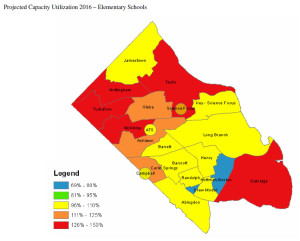 The 2012-2013 school year is a big one for Arlington Public Schools, as it takes on the task of changing school boundaries and admissions policies. The first opportunity for the public to get involved is at a School Board work session tonight (Wednesday).
The 2012-2013 school year is a big one for Arlington Public Schools, as it takes on the task of changing school boundaries and admissions policies. The first opportunity for the public to get involved is at a School Board work session tonight (Wednesday).
At the meeting, the School Board will review the current boundary policy and discuss the scope of the boundary changes to be considered. The work session will take place in room 101 of the Education Center (1426 N. Quincy Street) at 7:45 p.m.
The public is allowed to attend but not offer comments at the work session, which is considered a preliminary meeting to figure out the direction the boundary process will take in the coming months. Public engagement sessions will officially kick off late next month. At that time, residents may raise concerns and offer suggestions for boundary issues requiring further examination.
“We’re very interested in being transparent and engaged with the community in this process. We want people to be engaged because boundary changes will be a part of our future for many years,” said APS Director of Facilities Planning Alison Denton. “We want to establish a process that works and that is transparent.”
Policy requires this process for projects listed in the proposed APS Capital Improvement Plan (CIP) presented by Superintendent Dr. Patrick Murphy in May. The $538 million CIP includes funding for two new elementary schools and additions to three others to address the school system’s capacity issues.
“We’re seeing an influx of students to the point where we’re running out of space, especially at the elementary level,” said APS spokesman Frank Bellavia.
In preparation for the new schools and new additions, new school boundaries must be decided upon to better distribute students in the most overcrowded areas, such as the northwest portion of the county.
“This is just the beginning discussion. We don’t know yet how large the boundaries are going to be or how small they’re going to be,” Bellavia said.
So far, there’s no firm timetable for having a boundary plan completed. It could be finished by the end of this school year, but that’s still up in the air and should be discussed at tonight’s work session, according to Denton.
Another part of the overall planning process involves designing the addition to Ashlawn Elementary School, scheduled for completion in 2014, and a new elementary school at the Williamsburg Middle School site, scheduled to open for the 2015-2016 school year. The Building Level Planning Committees (BLPC), which consist of parents, teachers, civic association representatives, APS staff and county staff, began developing designs for the two projects last week. Although preliminary renderings were already devised during feasibility studies last year, they will be scrapped and new designs will be drawn from scratch.
“We need to look at the overarching plan and then start talking specifically about the first decision, which is developing a new neighborhood school boundary for the Williamsburg site,” Denton said.
While determining boundaries, it will also be decided whether certain students will get grandfathered in so they don’t have to switch schools for just one year. Denton said that decision ultimately is made by the School Board, and tends to differ in each boundary situation. In the case of the new Williamsburg school, however, new boundaries aren’t simply needed for easing crowding like at other schools; it’s also a matter of filling classrooms. That may mean less wiggle room with allowing students to remain at their current schools.
“Williamsburg requires boundary changes because we don’t have a community for that school. We need to draw a boundary or we won’t be able to send anyone to school there in 2015,” Denton said. “We have to balance the needs of the kids and not wanting to move them for the last year of school, but at the same time we need to fill the seats. We will always look at that as part of the boundary decision.”
Although boundary changes can sometimes prove contentious, Denton believes parents will see the benefits of the outcome and will respond positively in the end.
“I think people are really excited about improving their schools and building a new school,” said Denton.
The 10 year CIP introduced earlier this year was a first for APS; previously a CIP was devised every two years. However, the new CIP does allow for re-examining projects and capacity needs every two years.

